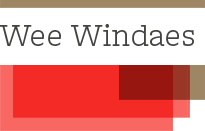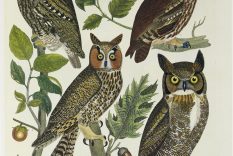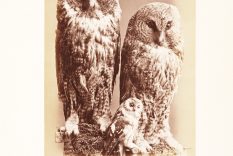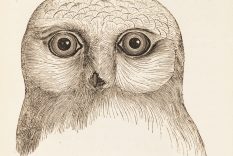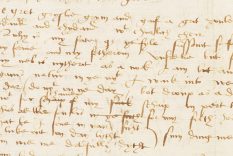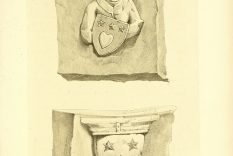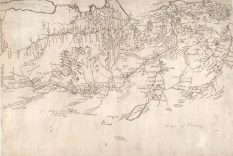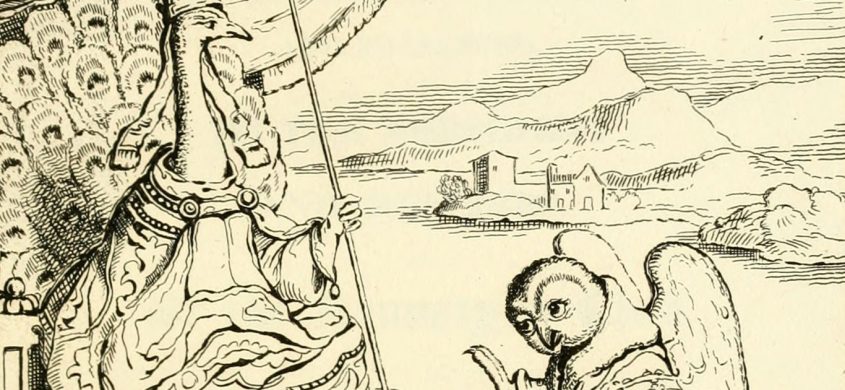
‘The Buke of the Howlat’ is a paukie an ferlie tale scrievit bi Richard Holland in the 1440s an dedicatit tae Lady Elizabeth Douglas at Darnaway Castle in Morayshire. Alike in theme tae Chaucer’s ‘Parliament of Foules’, the fable tells hou the cleric Richard Holland is stravaigin the wids aside the River Findhorn whan he meets wi Howlat, the owl an eponymous anti-hero o the tale.
The blate bird girns anent his fate as he trows himsel tae be the maist uggsome craitur o Natur’s kingdom, ‘lykar a fule than a fowle in figure an face’ – syne Howlat’s tale unfaulds.
Lear mair aboot The Buke of the Howlat
In a meession tae address his plicht Howlat gangs tae the Pope wha is representit bi the peajock in his colourfu plumage. The Holy Faither then cries his offices tae cooncil – swallaes for messangers, cranes for cardinals, swans as bishops, while pyets, plivers an paitriks are abbots. The whitterick is chancellor bi docht o bein able tae scrieve wi his neb in the saund. In firder pursuit o the maitter the secular pouers are hoyed, amang them the emperor eagle, king erne an the sparrahawk ‘knychtis’. The herald is representit bi the specht – the green widpecker.
Syne the tale diverges intae a fair digression on the powerfu Douglas faimily airms an cause, whiles relatin the story o the Douglas knycht cairryin the hert o Robert the Bruce tae the Crusades. Returnin tae the tale, it is decreed that ilka bird will gie ane o its feathers tae Howlat in an effort tae impruive his luiks an staundin. Made bonnie an swalled wi conceit, new-luik Howlat blaws his ain trumpet an struts his stuff, but ainly tae the dismay o the ither birds wha promptly retrieve thair feathers, lea’in him hingin-luggit an touselt.
‘The Buke of the Howlat’ staunds as an important moment in Scottish literary history. The poem is alliterative in form, consistin o 13 line stanzas or ‘rouncefallis’, a kenspeckle featur o Early an Middle Scots literature. The rouncefallis wis later identified in King James VI’s imprent ‘Some Reulis and Cautelis to be observit and eschewit in Scottis poesie’ whaur he scrieves: ‘For Flytings, or Invectives, use this kynde of verse following, callit Rouncefallis or Tumbling Verse.’
Whiles scrievit in a script that micht pruive a trauchle tae the general reader, the text hauds a rowth o Scots wirds an pronunciations that micht be familiar in the present day. Amang them are:
- lang (long)
- warld (world)
- sicht (sight)
- neb (nose)
- dicht (strike)
- deid (dead)
- speir (inquire)
- kirk (church)
- scaith (trouble)
- corbie (crow)
- wee (small)
- ettle (intend)
- nakit (naked)
- concludit (concluded)
Forby are ither wirds sic as ‘laith’ which micht be familiar frae literary references sic as in Robert Burns’s ‘To a Mouse’: ‘I wad be laith tae rin an chase thee / Wi murd’ring prattle!’
Specht, the heraldic green widpecker o the tale, is the contemporary name for a widpecker in Dutch.
It is unrecordit as tae whither ‘The Buke of the Howlat’ wis performed in the great ha at Darnaway Castle or itherwhaur, but gien its structure an alliterative form, as weel as ruisin up the Douglas cause, it is considert tae follae in the bardic or court poem tradition. In ‘The Cambridge history of medieval English ;iterature’, editor David Wallace scrieves:
‘The attention devoted to feasting and entertainment and the theatrical display of the Douglas heraldic arms strongly suggests the poem was commissioned for a specific court entertainment.’
In the 2014 edition imprentit bi the Scottish Texts Society an editit bi Ralph Hannah, the editor cites the interest ‘The Buke of the Howlat’ wid haud fir Middle Scots makars sic as William Dunbar an Robert Henrysoun, the latter o wham wid uphaud themes o natur an morality in his ‘Morall Fabillis’, a revived Classical tradition popular in Europe that wid later be uphaudit bi Allan Ramsay in his animal fables scrievit atween 1720 tae 1730.
Imprentit in 1507 bi Chepman and Myllar in Edinbrugh frae the survivin fragment o a 15th century manuscript, ‘The Buke of the Howlat’ wis preserved in baith the Asloan an Bannatyne manuscripts. An 1823 edition in Gothic copperplate wis imprentit bi the Bannatyne Club. ‘The Book of the Howlat’ wis ane o the first prentint bukes in Scotland an is the auldest kent example o alliterative verse in Scottish literatur, whiles bein a poem which baith entertains an gies clues tae speech patterns still extant in 21st Century Scotland. In September 2016 a bairn’s version o ‘The Buke of the Howlat’ wis imprentit bi BC Books, wi text bi James Robertson an picters bi Kate Leiper.
‘The Buke of the Howlat’ is a shrewd and curious tale written by Richard Holland in the 1440s and dedicated to Lady Elizabeth Douglas at Darnaway Castle in Morayshire. Similar in theme to Geoffrey Chaucer’s ‘Parliament of Fowls’, the fable relates how the priest Richard Holland is wandering in the woods beside the River Findhorn when he meets with Howlat, the owl and eponymous anti-hero of the tale.
The sheepish bird bemoans his fate as he believes himself to be the ugliest creature of nature’s kingdom: ‘lykar a fule than a fowle in figure and face’ – thereupon Howlat’s tale unfolds.
Learn more about The Buke of the Howlat
In a mission to address his plight Howlat goes to the Pope who represented by the peacock in his colourful plumage. The Holy Father then summons his offices to council – swallows for messengers, cranes for cardinals, swans as bishops, while magpies, plovers and partridges are abbots. The curlew is chancellor by virtue of being able to write with his beak in the sand. In further pursuit of the matter the secular powers are called on, among them emperor eagle, king erne and the sparrow-hawk knights. The herald is represented by the specht – the green woodpecker.
Thereon the tale diverges into a considerable digression on the powerful Douglas family arms and cause, while relating the story of the Douglas knight carrying the heart of Robert the Bruce to the Crusades. Returning to the tale, it is decreed that each bird will give one of its feathers to Howlat in an effort to improve his looks and standing. Made beautiful and puffed up with conceit, new look Howlat blows his own trumpet and struts his stuff, but only to the dismay of the other birds who promptly retrieve their feathers leaving him crestfallen and dishevelled.
‘The Buke of the Howlat’ stands as an important moment in Scottish literary history. The poem is alliterative in form, consisting of 13-line stanzas, or ‘rouncefallis’, a distinctive feature of Early and Middle Scots literature. The rouncefallis was later identified in King James VI’s book ‘Some Reulis and Cautelis to be observit and eschewit in Scottis poesie’ where he writes: ‘For Flytings, or Invectives, use this kynde of verse following, callit Rouncefallis or Tumbling Verse.’
While written in a script that might prove challenging to the general reader, the text contains a wealth of Scots words and pronunciations that might be familiar in the present day. Among these are:
- lang (long)
- warld (world)
- sicht (sight)
- neb (nose)
- dicht (strike)
- deid (dead)
- speir (inquire)
- kirk (church)
- scaith (trouble)
- corbie (crow)
- wee (small)
- ettle (intend)
- kenned (known).
There are also words such as ‘laith’ which might be familiar from literary references such as in Robert Burns’s ‘To a Mouse’: ‘I wad be laith tae rin an chase thee / Wi murd’ring prattle!’
‘Specht’, the heraldic green woodpecker of the tale is the contemporary name for a woodpecker in Dutch.
It is unrecorded as to whether ‘The Buke of the Howlat’ was performed in the great hall at Darnaway Castle or elsewhere. However, given its structure and alliterative form as well as its dedication to the Douglas family, it can be regarded as following the bardic or court poem tradition. In ‘The Cambridge history of medieval English literature’, editor David Wallace writes:
‘The attention devoted to feasting and entertainment and the theatrical display of the Douglas heraldic arms strongly suggests the poem was commissioned for a specific court entertainment.’
In the 2014 edition published by the Scottish Texts Society and edited by Ralph Hannah, the editor cites the interest ‘The Buke of the Howlat’ would hold for Middle Scots makars such as William Dunbar and Robert Henrysoun, the latter of whom would uphold themes of nature an morality in his ‘Morall Fabillis’, a revived Classical tradition popular in Europe that would later be upheld by Allan Ramsay in his animal fables written between 1720 and 1730.
Published in 1507 by Chepman and Myllar in Edinburgh from the surviving fragment of a 15th century manuscript, ‘The Buke of the Howlat’ was preserved in both the Asloan and Bannatyne manuscripts. An 1823 edition in Gothic copperplate was published by the Bannatyne Club. ‘The Buke of the Howlat’ was one of the first printed books in Scotland and is the oldest known example of alliterative verse in Scottish literature, while being a poem which both entertains and provides clues to speech patterns still extant in 21st Century Scotland. In September 2016 a children’s version of ‘The Buke of the Howlat’ was published by BC Books, with text by James Robertson and illustrations by Kate Leiper.
- Author:
- Sir Richard Holland, priest and former canon of Kirkwall. Died circa 1483.
- Publication Date:
- 1440
- Imprentit:
Manuscript fragment circa 1470s. Chepman and Myllar, Edinbrugh 1508.
Bannatyne Club, Edinbrugh 1823. Bannatyne Club, related lecture 1827. Scottish Texts Society, edited by Ralph Hannah, 2014.
‘The Buke of the Howlat’
Thus all thir fowlis, fir my filth, has me at seid
That be I seyne in thar sicht
To luke out on day licht
Sum will me dulfully dicht
Sum dyng me to deidFrae ‘The Buke of the Howlat’
